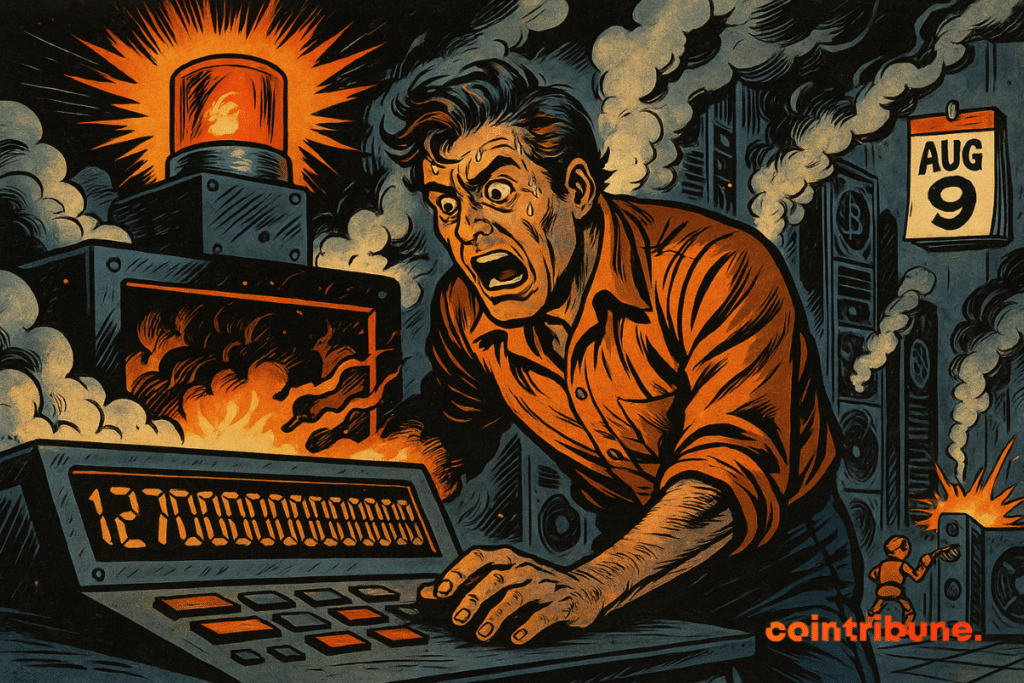Bitcoin Mining Difficulty Smashes 127 Trillion Barrier—Next Adjustment Looms August 9
Bitcoin's backbone just flexed harder than a Wall Street trader's excuses. The network's mining difficulty—that brutal cryptographic gatekeeper—crashed through 127 trillion like it was a paper barrier.
What's next? A scheduled difficulty recalibration in six days. August 9th marks the next make-or-break moment for miners sweating over their rigs' profitability.
This isn't just numberwang—it's survival math. Every hash rate uptick forces miners to either upgrade or get left behind. Meanwhile, traditional finance bros still think 'blockchain' is a new Peloton accessory.
One thing's certain: Bitcoin's immune system—that beautiful, ruthless difficulty algorithm—keeps working exactly as designed. No central bank meetings required.

In Brief
- Bitcoin network mining difficulty reached a record 127.6 trillion at the end of July.
- An adjustment is planned for August 9 to bring this difficulty around 123.7 trillion.
- Bitcoin remains twice as rare as gold, with 94% of supply already mined.
- Miners earn up to $57,400 per exahash, despite a 3% drop in BTC price.
Absolute record: Bitcoin under computing pressure
The difficulty ofreaches, according to CoinWarz. This indicator measures thefor miners to. In short, the higher the number climbs, the more competitive the network is. This record level reflects an increase in global hashrate and mining intensity.
In June,, but the trend reversed by mid-July.
Theshould lower difficulty by 3%, around 123.7 trillion. This correction is required due to ancurrently too long:, while the protocol targets exactly 10 minutes. This self-regulation ensures the network is neither too slow nor too fast.
The adjustment cycle, every two weeks, protects bitcoin from overproduction, ensuring the stability of its issuance schedule. The current record is not trivial: it reflects, but also pressure on profitability. This technical peak is therefore both an achievement and a warning signal.
Bitcoin, rarer than gold: the central role of stock-to-flow
Bitcoin has a secret: its. According to the stock-to-flow model popularized by analyst PlanB, BTC today has. This means the current stock is 120 times higher than the new annual production. For comparison, Gold caps around 60, and silver even lower. The difference? Gold can be mined without limit, whereas bitcoin is capped at 21 million units. With, the room for creation is shrinking.
This is where difficulty comes into play. By regulating issuance, it preserves scarcity, the key to value. This setup protects Bitcoin from supply shocks like those which historically weighed down silver prices. The system is therefore designed to, unlike traditional metals.
This regulation has led institutions to consider bitcoin as a SAFE haven asset, even as a digital version of gold. But unlike gold, no industrial lobby can influence production. It is mathematically locked.
Price tension: the paradox between profitability and market
Despite the record difficulty,at the end of July. It fell to $112,680 before rebounding to. This correction occurred while the network is more secure than ever. Hard to believe? Not really. The market reacts to economic flows, not just technical fundamentals.
BTCUSD chart by TradingViewIn South Korea, the– gap between local and global price – returned, reaching +0.84%, reflecting increased regional demand. Meanwhile,jumped to, their highest level since the halving. This contrast reveals a discrepancy: the network is more efficient, but the market remains unstable.
Analysts point to a temporary decoupling between scarcity signals (stock-to-flow) and spot price.
Bitcoin thus continues to widen the gap between its economic structure and its market performance. In this dynamic, miners adapt, optimize, and… cash out. Here are the key figures to remember:
- 127.6 trillion difficulty: record reached in July;
- 123.7 trillion expected after the August 9 adjustment;
- 94% of BTC already mined;
- $57,400 daily revenue per EH/s;
- 0.84% Kimchi premium on the South Korean market.
Despite a hashrate close to the historic peak, bitcoin miners benefit from a return to stable profitability. The network remains secure, efficient, and economically viable.
Maximize your Cointribune experience with our "Read to Earn" program! For every article you read, earn points and access exclusive rewards. Sign up now and start earning benefits.

